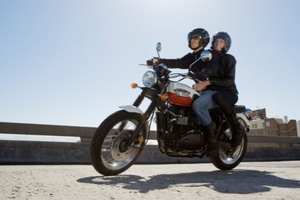If you ride a motorcycle, you may want to share the thrill of experiencing the open road on two wheels with people you love. But you may also be wondering if there is something you need to do first before letting your spouse, child, or a friend hop on the back with you.
Thankfully, there’s nothing stopping you from taking a passenger—or in motorcycle lingo, a “pillion”—with you on your motorcycle, so long as you meet a few simple safety requirements.
But when other road users break the law and negligent drivers put you and your passenger in danger, the motorcycle injury attorneys at the Law Offices of Gary Bruce are ready to represent you against insurance companies who may try to hold riding with a passenger against you without cause.
Because insurance companies are already strongly biased against motorcycle riders and view them as reckless, you should always call an attorney after a motorcycle crash involving another vehicle — especially before you give a recorded statement or meet with an adjuster.
What State Law Says About Motorcycle Passengers
Although what is legally required to operate a motorcycle with or without a passenger can vary from state to state, Alabama and Georgia have very similar laws.
- The motorcyclist must have a full motorcycle license. Riders with only a permit are not allowed to carry passengers.
- Passengers must have a dedicated seat and footrests, and no more than one passenger is allowed per bike. If your motorcycle wasn’t designed to carry two or you don’t have a sidecar installed, then stick to riding solo.
- Passengers are required to wear a helmet and appropriate footwear. In Georgia, eye protection is also required if the helmet does not include a visor. Sunglasses are not considered appropriate eye protection, so make sure to invest in motorcycle goggles for any passenger you may want to carry.
- There are no restrictions on passenger age, so your child is good to ride as a passenger if they wear the appropriate safety gear.
Tips for Safely Riding with a Passenger on Your Motorcycle
Because the handling of a motorcycle is easily influenced by the shifting of the rider, carrying a passenger isn’t as simple as carrying a passenger in a car or SUV. It takes a little practice. If you’d like to bring someone with you for a ride on your motorcycle, here are some tips that can help keep the both of you safe.
What to Tell Your Passenger
- Make sure your passenger dresses appropriately for the ride, with closed-toe shoes, gloves, and clothes that expose as little skin as possible to protect against road rash in a crash.
- Point out where the bike gets hot, like the muffler, so they can avoid burning themselves during the ride.
- Passengers should get on from the left side after you get on, placing their left foot on the peg and gripping your left shoulder while swinging their leg over.
- Stress the importance of not making any sudden movements or shifts in weight that could unbalance the bike while it’s in motion. For this same reason, tell your passenger to wait until you give the okay before getting on the bike, and not to put their feet down when the bike stops at a traffic signal.
- Encourage your passenger to lean in the same direction as you when making a turn. Their instinct may be to lean in the opposite direction.
- Encourage your passenger to hold tightly onto you or any available handholds designed for that purpose. The more space between you and your passenger on the bike means the more likely they are to bump into you when the motorcycle is accelerating or braking.
What You Need to Know
- If you’re riding a new bike, don’t bring a passenger on it right away. Take some time to get familiar with its characteristics.
- If you’re going for anything longer than a short ride, it may be worth considering adjusting your suspension and tire pressure to account for a passenger – the recommended settings should be listed in your bike’s owner’s manual.
- When the passenger is getting on or off, hold the bike as upright as possible, bracing on both sides with your legs to keep it steady. Don’t let the stand alone do all the work.
- Keep in mind that with the added weight of a passenger, you’ll also need to rev the engine higher before you release the clutch, and it will also take longer to come to a stop, so you’ll need to brake earlier.
- Remember, YOUR PASSENGER’S SAFETY IS IN YOUR HANDS! Go a little slower and more cautiously than you may when riding alone.
- Optional: Read Zen and the Art of Motorcycle Maintenance by Robert M. Pirsig for a perspective on motorcycle ownership, if you like modern classics.
If You’ve Been Injured in a Motorcycle Crash, We Want to Help You Get Compensation
Unfortunately, even the most conscientious motorcycle rider can’t prevent all crashes when they have to share the road with reckless, distracted, or road-raging drivers who don’t know how to or want to share the road with motorcycles.
If you or someone you love has been injured in a motorcycle crash, and another driver was at fault, you may be eligible for compensation.
We’ve earned a reputation in our communities as being reliable, knowledgeable, and always ready to stand between our clients and the big insurance companies. So if you want a firm that will explain your options to you in a way you understand, help you determine what you are owed, and fight for your rights every step of the way, contact our motorcycle injury lawyers for a free case evaluation.
